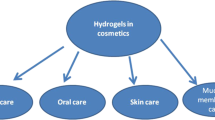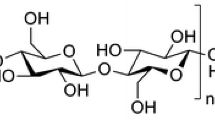Abstract
Biocompatible polymer sponge materials based on biodegradable natural polymer chitosan, which can be loaded with clinician-selected drugs are still in the centre of interest for their wide use in clinical practice. This study shows possibilities of the technology which combines simple addition of β-cyclodextrin (β-CD), with dialdehyde starch (DAS) as a cross-linking agent of chitosan, to chitosan solutions for subsequent formation of sponge matrix. The advantage of such system is in avoiding chemical modifications and working only with natural substances. It is shown that, in matrix formation during lyophilisation, β-CD molecules tend to accumulate on the surface of the porous matrix structure. This was confirmed by a study of the known inclusion complex of β-CD and salicylic acid (SA) in heptane. The same study was applied to berberine (BER) which can also form an inclusion complex with β-CD in a water solution. Moreover, adsorption of drugs on the surface of the porous structure has to be also taken into account. This enables the production of sponge topical medical preparations useful for sustained release of BER.
Similar content being viewed by others
References
Arun, R., Ashok Kumar, C. K., & Sravanthi, V. V. N. S. S. (2008). Cyclodextrins as drug carrier molecule: A review. Scientia Pharmaceutica, 76, 567–598. DOI: 10.3797/scipharm. 0808-05.
Belyakova, L. A., Varvarin, A. M., Lyashenko, D. Y., Khora, O. V., & Oranskaya, E. I. (2007). Complexation in a β-cyclodextrin—salicylic acid system. Colloid Journal, 69, 546–551. DOI: 10.1134/s1061933x0705002x.
Felt, O., Buri, P., & Gurny, R. (1998). Chitosan: A unique polysaccharide for drug delivery. Drug Development and Industrial Pharmacy, 24, 979–993. DOI: 10.3109/036390498090 89942.
Hirano, S., Seino, H., Akiyama, Y., & Nonaka, I. (1990). Chitosan: A biocompatible material for oral and intravenous administrations. In C. G. Gebelein, & R. L. Dunn (Eds.), Progress in biomedical polymers (pp. 283–290). New York, NY, USA: Springer. DOI: 10.1007/978-1-4899-0768-4_28.
Ikeda, T., Ikeda, K., Yamamoto, K., Ishizaki, H., Yoshizawa, Y., Yanagiguchi, K., Yamada, S., & Hayashi, Y. (2014). Fabrication and characteristics of chitosan sponge as a tissue engineering scaffold. BioMed Research International, 2014, article ID 786892. DOI: 10.1155/2014/786892.
Illum, L. (1998). Chitosan and its use as a pharmaceutical excipient. Pharmaceutical Research, 15, 1326–1331. DOI: 10.1023/a:1011929016601.
Knapczyk, J. (1993). Excipient ability of chitosan for direct tableting. International Journal of Pharmaceutics, 89, 1–7. DOI: 10.1016/0378-5173(93)90301-u.
Ko, J. A., Park, H. J., Hwang, S. J., Park, J. B., & Lee, J. S. (2002). Preparation and characterization of chitosan microparticles intended for controlled drug delivery. International Journal of Pharmaceutics, 249, 165–174. DOI: 10.1016/s0378-5173(02)00487-8.
Kumbar, S. G., Kulkarni, A. R., & Aminabhavi, T. M. (2002). Crosslinked chitosan microspheres for encapsulation of diclofenac sodium: Effect of crosslinking agent. Journal of Microencapsulation, 19, 173–180. DOI: 10.1080/026520401100 65422.
Li, N., & Xu, L. (2010). Thermal analysis of β-cyclodextrin/berberine chloride inclusion compounds. Thermochimica Acta, 499, 166–170. DOI: 10.1016/j.tca.2009.10.014.
Mi, F. L., Shyu, S. S., Wu, Y. B., Lee, S. T., Shyong, J. Y., & Huang, R. N. (2001a). Fabrication and characterization of a sponge-like asymmetric chitosan membrane as a wound dressing. Biomaterials, 22, 165–173. DOI: 10.1016/s0142-9612(00)00167-8.
Mi, F. L., Tan, Y. C., Liang, H. C., Huang, R. N., & Sung, H. W. (2001b). In vitro evaluation of a chitosan membrane crosslinked with genipin. Journal of Biomaterials Science, Polymer Edition, 12, 835–850. DOI: 10.1163/156856201753113 051.
Mi, F. L., Wu, Y. B., Shyu, S. S., Schoung, J. Y., Huang, Y. B., Tsai, Y. H., & Hao, J. Y. (2002). Control of wound infections using a bilayer chitosan wound dressing with sustainable antibiotic delivery. Journal of Biomedical Materials Research, Part A, 59, 438–449. DOI: 10.1002/jbm.1260.
Noel, S. P., Courtney, H. S., Bumgardner, J. D., & Haggard, W. O. (2010). Chitosan sponges to locally deliver amikacin and vancomycin: A pilot in vitro evaluation. Clinical Orthopaedics and Related Research, 468, 2074–2080. DOI: 10.1007/s11999-010-1324-6.
Patel, V. R., & Amiji, M. M. (1996). Preparation and characterization of freeze-dried chitosan-poly(ethylene oxide) hydrogels for site-specific antibiotic delivery in the stomach. Pharmaceutical Research, 13, 588–593. DOI: 10.1023/a:1016054306 763.
Pavlath, A. E., Wong, D. W. S., & Robertson, G. H. (1996). Chitosan (preparation, structure, and properties). In J. C. Salamone (Ed.), Polymeric materials encyclopedia (pp. 12301234). Boca Raton, FL, USA: CRC Press.
Piyakulawat, P., Praphairaksit, N., Chantarasiri, N., & Muangsin, N. (2007). Preparation and evaluation of chitosan/carrageenan beads for controlled release of sodium diclofenac. AAPS Pharm Sci Tech, 8, article 97, E1–E11. DOI: 10.1208/pt0804097.
Prabaharan, M., & Mano, J. F. (2006). Chitosan derivatives bearing cyclodextrin cavities as novel adsorbent matrices. Carbohydrate Polymers, 63, 153–166. DOI: 10.1016/j. carbpol.2005.08.051.
Ravi Kumar, M. N. V., Muzzarelli, R. A. A., Muzzarelli, C., Sashiwa, H., & Domb, A. J. (2004). Chitosan chemistry and pharmaceutical perspectives. Chemical Reviews, 104, 60176084. DOI: 10.1021/cr030441b.
Schiffman, J. D., & Schauer, C. L. (2007). Cross-linking chitosan nanofibers. Biomacromolecules, 8, 594–601. DOI: 10.1021/bm060804s.
Serrero, A., Trombotto, S., Cassagnau, P., Bayon, Y., Gravagna, P., Montanari, S., & David, L. (2010). Polysaccharide gels based on chitosan and modified starch: Structural characterization and linear viscoelastic behavior. Biomacromolecules, 11, 1534–1543. DOI: 10.1021/bm1001813.
Shigemasa, Y., & Minami, S. (1996). Applications of chitin and chitosan for biomaterials. Biotechnology and Genetic Engineering Reviews, 13, 383–420. DOI: 10.1080/02648725.1996. 10647935.
Tang, R., Du, Y., & Fan, L. (2003). Dialdehyde starch-crosslinked chitosan films and their antimicrobial effects. Journal of Polymer Science: Part B: Polymer Physics, 41, 993–997. DOI: 10.1002/polb.10405.
Tual, C., Espuche, E., Escoubes, M., & Domard, A. (2000). Transport properties of chitosan membranes: Influence of crosslinking. Journal of Polymer Science: Part B: Polymer Physics, 38, 1521–1529. DOI: 10.1002/(SICI)1099-0488(20000601)38:11< 1521::AID-POLB120>3.0.CO;2-#.
Vodna, L., Bubenikova, S., & Bakos, D. (2007). Chitosan based hydrogel microspheres as drug carriers. Macromolecular Bioscience, 7, 629–634. DOI: 10.1002/mabi.200600290.
Yu, J. S., Wei, F. D., Gao, W., & Zhao, C. C. (2002). Thermodynamic study on the effects of β-cyclodextrin inclusion with berberine. Spectrochimica Acta Part A: Molecular and Biomolecular Spectroscopy, 58, 249–256. DOI: 10.1016/s1386-1425(01)00536-4.
Zohuriaan-Mehr, M. J. (2005). Advances in chitin and chitosan modification through graft copolymerization: A comprehensive review. Iranian Polymer Journal, 14, 235–265.
Author information
Authors and Affiliations
Corresponding author
Rights and permissions
About this article
Cite this article
Hnátová, M., Bakoš, D., ČCernáková, L. et al. Chitosan sponge matrices with β-cyclodextrin for berberine loading. Chem. Pap. 70, 1262–1267 (2016). https://doi.org/10.1515/chempap-2016-0015
Received:
Revised:
Accepted:
Published:
Issue Date:
DOI: https://doi.org/10.1515/chempap-2016-0015




